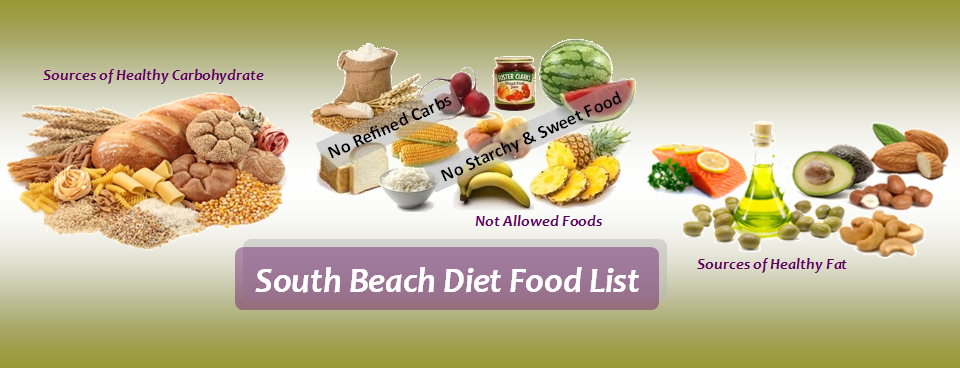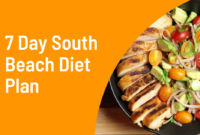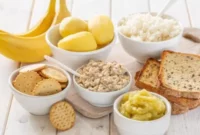South Beach Diet vs Atkins: This comparison delves into the intricacies of two popular weight-loss diets, exploring their core principles, effectiveness, potential risks, and practical applications. We’ll examine the macronutrient breakdowns, allowed and restricted foods, and the phased approaches of each diet. Understanding the metabolic impact and potential nutrient deficiencies is crucial for making an informed choice.
This in-depth analysis aims to provide a comprehensive overview, assisting readers in determining which diet, if either, best aligns with their individual needs and health goals. We’ll consider factors such as ease of adherence, suitability for various health conditions, and long-term sustainability. The information presented here is for educational purposes and should not substitute professional medical advice.
Weight Loss Mechanisms
Both the South Beach Diet and the Atkins Diet promote weight loss, but they achieve this through different metabolic pathways. Understanding these mechanisms is crucial for determining which diet might be more suitable for an individual. Both diets manipulate carbohydrate intake, but their approaches and the resulting metabolic responses differ significantly.
Metabolic Effects and Weight Loss
The South Beach Diet emphasizes a gradual reduction in carbohydrate intake, focusing on “good” carbohydrates like whole grains and fruits while limiting refined carbohydrates and sugars. This approach aims to stabilize blood sugar levels and insulin response, preventing the surges and crashes associated with rapid weight gain. In contrast, the Atkins Diet is a very low-carbohydrate diet, drastically restricting carbohydrate intake to induce ketosis. Ketosis is a metabolic state where the body begins to burn fat for energy instead of glucose. The initial rapid weight loss seen on the Atkins diet is largely due to water loss associated with glycogen depletion (glycogen stores water). The South Beach Diet, while also leading to weight loss, typically results in a more gradual and potentially more sustainable weight loss due to its less restrictive approach.
The Role of Insulin and Glucagon
Insulin and glucagon are hormones that regulate blood sugar levels. When carbohydrates are consumed, insulin is released to facilitate the uptake of glucose into cells for energy. High insulin levels promote fat storage. The South Beach Diet, by controlling carbohydrate intake and emphasizing complex carbohydrates, aims to maintain more stable insulin levels, reducing fat storage and promoting fat burning. The Atkins Diet, by severely restricting carbohydrates, significantly lowers insulin levels. This reduction in insulin, combined with the body’s shift to ketosis, allows stored fat to be utilized for energy. Glucagon, on the other hand, is released when blood sugar levels are low. It stimulates the breakdown of glycogen (stored glucose) and the release of glucose into the bloodstream. Both diets, in their own way, influence glucagon secretion. The Atkins diet, through its drastic reduction of carbohydrates, causes a significant increase in glucagon secretion to mobilize stored energy. The South Beach Diet’s more moderate approach leads to a more moderate glucagon response.
Initial vs. Sustained Weight Loss
The Atkins diet often shows rapid initial weight loss, primarily due to water loss and glycogen depletion. This can be motivating in the short term, but sustaining this weight loss can be challenging due to the restrictive nature of the diet. Many individuals find it difficult to adhere to the strict limitations on carbohydrate intake long-term. The South Beach Diet, with its more gradual approach and focus on healthier food choices, tends to result in slower initial weight loss, but it often leads to more sustained weight loss and improved overall health markers. For example, a study might show that individuals on the Atkins diet lose a significant amount of weight in the first month, but a considerable portion of this is water weight. Conversely, individuals on the South Beach diet might show a slower initial weight loss but maintain a more consistent rate of weight loss over several months, resulting in greater long-term success.
Practical Application and Considerations
Successfully implementing any diet requires careful consideration of practical aspects beyond just the nutritional science. Both the South Beach Diet and the Atkins Diet present unique challenges and benefits in terms of adherence, suitability for different individuals, and overall lifestyle integration.
Ease of Adherence
The South Beach Diet, with its emphasis on whole grains, lean proteins, and healthy fats, generally proves easier to adhere to in the long term for many individuals. Meal preparation is relatively straightforward, involving familiar cooking methods. Grocery shopping focuses on readily available items found in most supermarkets. Social situations are also less challenging, as the diet allows for a wider variety of foods and doesn’t require strict avoidance of entire food groups. In contrast, the Atkins Diet, with its initial strict limitations on carbohydrates, can be more demanding. Meal preparation may require more specialized recipes and ingredients. Grocery shopping needs to be more carefully planned to avoid high-carbohydrate traps. Social events can be more difficult to navigate, requiring careful meal planning and potentially limiting choices.
Suitability for Different Individuals
The South Beach Diet’s focus on balanced nutrition and whole foods makes it suitable for a broader range of individuals, including those with some pre-existing conditions (though always consulting a physician before starting any diet is crucial). Its gradual approach to carbohydrate intake can be easier on the body than the rapid changes associated with the Atkins Diet. However, individuals with specific sensitivities to certain foods (e.g., gluten intolerance) should carefully adjust the meal plan accordingly. The Atkins Diet, with its very low-carbohydrate approach, can be effective for rapid weight loss in some individuals but may not be suitable for everyone. Individuals with kidney problems, for instance, might need to exercise extra caution, as the high protein intake can strain the kidneys. Those with pre-existing heart conditions should also consult a doctor before starting the diet. People with type 1 diabetes should absolutely avoid this diet.
Sample Meal Plans
The following are sample meal plans for one day on each diet. Remember that individual needs and caloric requirements vary greatly, and these are merely illustrative examples. Consult a nutritionist or registered dietitian for personalized plans.
South Beach Diet Sample Meal Plan
Breakfast: Oatmeal with berries and a sprinkle of nuts.
Lunch: Salad with grilled chicken or fish, mixed greens, and a light vinaigrette.
Dinner: Baked salmon with roasted vegetables (broccoli, asparagus, peppers).
Snacks: A handful of almonds, a piece of fruit.
Atkins Diet Sample Meal Plan (Induction Phase)
Breakfast: Scrambled eggs with cheese and bacon.
Lunch: Salad with tuna (in oil, not water) and avocado.
Dinner: Steak with a side of spinach.
Snacks: Cheese slices, hard-boiled eggs.
Glycemic Index and Impact
The glycemic index (GI) plays a significant role in understanding the impact of both the South Beach Diet and the Atkins Diet on blood sugar levels and overall health. The GI measures how quickly a carbohydrate-containing food raises blood glucose levels compared to a reference food (usually pure glucose). Understanding the GI of foods within each diet helps clarify their differing approaches to weight management and their potential effects on individuals with diabetes or prediabetes.
The South Beach Diet and the Atkins Diet differ considerably in their approaches to carbohydrate intake, leading to variations in the GI of their recommended foods. The South Beach Diet allows for a wider range of carbohydrate-containing foods, albeit emphasizing those with a lower GI, while the Atkins Diet severely restricts carbohydrate intake, leading to a predominantly low-GI food selection.
Glycemic Index of Foods in South Beach and Atkins Diets
The following table compares the glycemic index of foods typically consumed on each diet. Note that GI values can vary depending on factors such as food preparation and individual responses. These are approximate values for illustrative purposes.
| Food | South Beach Diet Glycemic Index Rating (Approximate) | Atkins Diet Glycemic Index Rating (Approximate) |
|---|---|---|
| Whole Wheat Bread | 70-75 | Not typically consumed |
| Brown Rice | 50-60 | Not typically consumed |
| Oatmeal | 55-70 (depending on preparation) | Limited consumption, often in small portions |
| Fruits (Berries, Apples) | 40-60 (varies by fruit) | Limited consumption, often restricted to lower-GI options like berries |
| Vegetables (Leafy Greens, Broccoli) | Low (generally below 20) | Generally encouraged, unlimited consumption |
| Lean Protein (Chicken, Fish) | 0 | Encouraged, unlimited consumption |
| Nuts and Seeds | Low to Moderate (varies by type) | Generally encouraged, moderate consumption |
| Cheese | 0 | Encouraged, moderate consumption |
Impact of Glycemic Index on Blood Sugar and Energy Levels
The South Beach Diet, with its emphasis on lower-GI foods, generally leads to a slower and more gradual rise in blood sugar levels after meals. This can result in more stable energy levels throughout the day and reduced cravings. The Atkins Diet, due to its very low carbohydrate intake, leads to a minimal impact on blood sugar levels, often resulting in initially lower energy levels until the body adapts to ketosis. However, once in ketosis, many individuals report sustained energy levels from fat burning.
Effects on Individuals with Diabetes or Prediabetes
Both diets can potentially benefit individuals with diabetes or prediabetes, although their approaches differ significantly. The South Beach Diet’s emphasis on lower-GI foods helps prevent large spikes in blood glucose, which is crucial for managing diabetes. The Atkins Diet’s extremely low-carbohydrate approach can also improve blood sugar control by minimizing insulin secretion. However, the Atkins Diet requires careful monitoring and medical supervision, particularly for those with diabetes, as the initial adaptation period can be challenging and potential side effects such as ketoacidosis need to be considered. Individual responses vary, and consulting a healthcare professional before starting either diet is essential, especially for individuals with diabetes or prediabetes.
Final Thoughts
Ultimately, the choice between the South Beach Diet and the Atkins Diet depends on individual preferences, health status, and lifestyle. While both can lead to initial weight loss, sustained success hinges on long-term adherence and a holistic approach to health. Careful consideration of potential risks and nutrient deficiencies, along with consultation with a healthcare professional, is strongly recommended before embarking on either diet.




